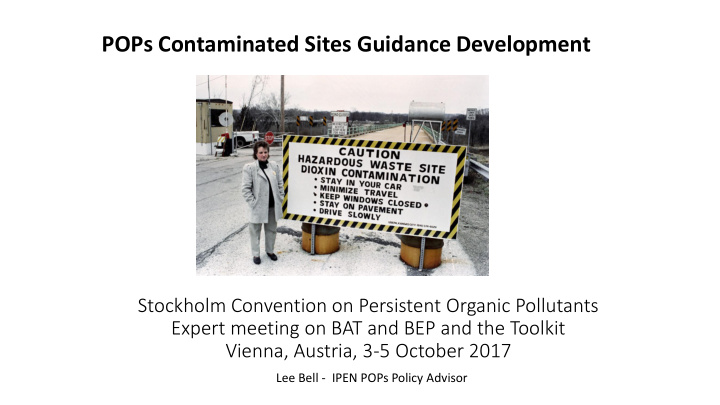



POPs Contaminated Sites Guidance Development Stockholm Convention on Persistent Organic Pollutants Expert meeting on BAT and BEP and the Toolkit Vienna, Austria, 3-5 October 2017 Lee Bell - IPEN POPs Policy Advisor
Background Article 6.1(e) of the Stockholm Convention on Persistent Organic Pollutants (‘POPs’) requires that parties endeavour to develop appropriate strategies for the identification of sites contaminated by chemicals listed in Annexes A, B or C of the Convention. Furthermore, if remediation of these sites is undertaken then it should be performed in an environmentally sound manner. This activity is situated within the Workplan for the ongoing review and update of the guidelines on best available techniques and provisional guidance on best environmental practices (Annex to decision SC-7/8) noted in the Annex to the Agenda for the Expert group meeting held in Bratislava, Slovakia, 29 September – 1 October 2015. Specifically, this activity related to section I (a)1, 4, 7, and (d) 14 of the Annex. Further, it is based in part on the themes in the paper tabled at the expert group meeting in Bratislava, Slovakia, 25-27 October 2016 and accompanying presentation by Roland Weber; L. Bell, R. Weber, B. De Borst, M.C. Paun, I. Holoubek, A.Watson, J. Vijgen(2016) ASSESSMENT OF POPS CONTAMINATED SITES AND THE NEED FOR STRINGENT SOIL STANDARDS FOR FOOD AND FEED SAFETY. (unpublished).
Proposed way forward for development of guidance Document tabled: Draft Preliminary Framework for Identification, Management and Remediation of POPs Contaminated Sites Guidance Development 1. A draft outline of the structure and content of the proposed contaminated sites guidance (Annex 2 ); 2. A preliminary compilation of materials to contribute to the ongoing development of the contaminated sites guidance by the Working Group (Annex 3 to this document). 3. A proposed road map for development of POPs Contaminated Sites Guidance for comment. (Annex 1 to this document);
A draft outline of the structure and content of the proposed contaminated sites guidance (Annex 2 ); • Site identification and characterization • Public Engagement • Human health and environmental risk assessment • Management of the risks posed by contaminated sites • Validation of outcomes • Cost benefit evaluation An example of a table of contents is proposed in the draft framework document and a similar model is followed by the UNIDO PERSISTENT ORGANIC POLLUTANTS: CONTAMINATED SITE INVESTIGATION AND MANAGEMENT TOOLKIT (2010 version).
Compilation of reference materials and tools (Annex 3) Currently includes; • Relevant scientific and policy citations; • Examples of regulatory approaches to management, risk assessment and remediation; • Toolkit approaches and similar resources; • Case studies; • Could be expanded to include links to databases, clearinghouses (CLU- In etc ) and so on.
Roadmap for guidance development Proposed Key Milestones : • Guidance outline and structure finalised - February 10, 2018 • Finalisation of draft compilation of materials - September 15 2018 • Presentation of draft guidance to expert group at face to face meeting and invitation for comments electronically following meeting – October 2018 • Final revision of guidance completed and circulated to expert group - January 30, 2019 • Tabling for consideration at appropriate SC venue at some point after January 30, 2019.
Issues for discussion among informal working group on POPs contaminated sites • Arrangements for consultation and feedback throughout the process. • Drafting by lead or by chapter by smaller teams? • Roadmap – is the timeframe appropriate? • Outline and structure – Is it sufficient to address the new POPs and what additions should be considered? • Can the compilation of materials be extended and if so how? • Key principles to address in a broader context such as SDGs and precautionary principles. • Synergies with the Basel and Minamata Conventions.
Thank you for your attention Lee Bell POPs Policy Advisor – International POPs Elimination Network leebell@ipen.org
Recommend
More recommend